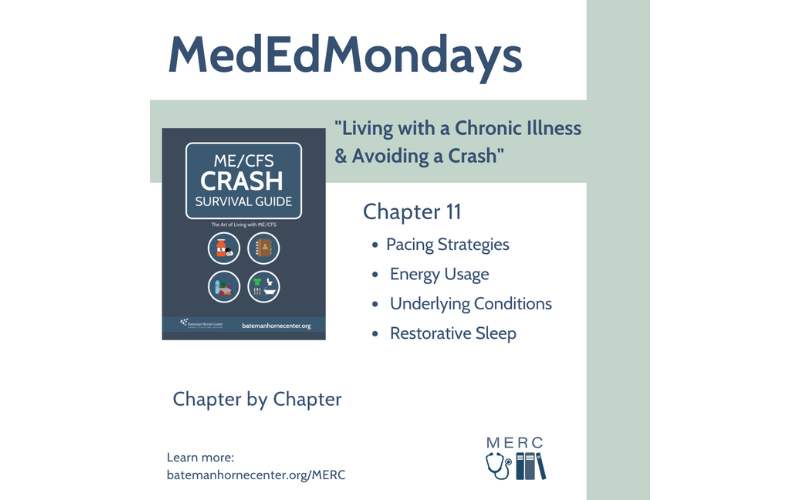This blog post covers the eleventh chapter of the ME/CFS Crash Survival Guide. The information provided can also apply to individuals with Long COVID and other multi-system chronic complex illnesses that have post-exertional malaise (PEM) symptoms.
Click here to download the entire guidebook.
Chapter 11: Living with a Chronic Illness and Avoiding the Crash
While living with ME/CFS, it is vital to learn the art of preventing and minimizing PEM and a subsequent crash. While not in a crash state, familiarize yourself with resources that can assist you in conserving energy and apply these following concepts to your everyday life.
Pacing
Pacing is the golden rule when living with ME/CFS; however, it can be one of the hardest to implement and master. Pacing applies to all activities. Energy consumers come in the form of physical, emotional, cognitive, and orthostatic demands. Environmental and sensory stimuli also contribute to energy depletion.
Strategies
- Take frequent and restorative breaks.
- Set timers during activities to give reminders and prompts to rest.
- Aim to use 80% of your energy, while saving 20% each day so you generate a reserve and avoid entering a state of PEM.
- Go horizontal for 10-15 minutes every couple of hours if possible.
- Schedule “brain breaks.”
- Time management = pace management
- Break up or modify activities or tasks into smaller and more manageable increments.
- Sit or keep legs elevated when performing activities that you might otherwise complete while standing.
- Dishes, folding laundry, doing your hair/makeup, etc.
- Shower chairs can sometimes mean the difference between an episode of PEM or a restoring shower.
- Wearable devices that track heart rate
- Increases in heart rate, no matter the activity or stressor, can serve as a physiological cue to stop and rest.
- Be mindful of the energy utilized with cognitive processing (and filtering) activities.
- Reading, writing, talking, processing a TV show/movie, etc.
- High stimulating environments can overwhelm cognitive processing.
- Emotional responses, whether positive or negative, can trigger PEM (sometimes unavoidable).
- Set appropriate boundaries to protect your energy utilization of information consumption (media, news, conversing with family/friends, etc.).
- Don’t beat yourself up if and when you crash.
- Sometimes crashes are completely outside of your control.
- Fixating on the how’s and why’s do not help you to relax and restore.
- Give yourself grace and trust your body
Other Considerations
<span style="color:red">Do not introduce any additional sodium or supplements into your diet without consulting with your medical team. Additional consumption of these items may be contraindicated for your specific conditions (heart, kidney concerns, etc.).</span>
Target and treat underlying health conditions which can trigger, worsen, or prolong PEM episodes
- Mast cell activation syndrome (MCAS)
- Orthostatic intolerance (OI) syndromes
- Kidney and liver disease
- Endocrine disorders/diseases
- Autoimmune
- Pain amplification disorders
- Sleep disturbances
Eat well and stay hydrated
- Your body needs fuel/energy to use and store.
Orthostatic intolerance
- Pre-hydrate with electrolyte products 15 minutes prior to activity.
- Use electrolyte products as a rescue supplement when you feel yourself starting to become symptomatic.
- Consider the two-bottle method:
- One bottle with rehydration product that you sip on all day.
- Have a second “chugging” bottle filled with electrolytes used to pre-hydrate for an event.
- Your provider can help you to find the right sodium-to-water ratio. You can use your urine output and color as a guiding point, assuming you are drinking 2-3L of fluid a day. Aim for a normal output which is:
- Approximately 20 seconds of steady stream
- Light yellow color
- Normal frequency (5-6 times/day)
- Consider asking your provider to prescribe saline IVs which will be administered by a healthcare professional to stave off a crash, or speed up recovery.
- 0.9% Normal Saline solution @ 1.5L over 60-90 minutes
- Seek pharmacological interventions as appropriate.
- When using compression clothing, aim to have as much body surface covered as feasible.
- Target core/abdomen, legs, and arms
Target restorative sleep
- Maintain good sleep hygiene.
- Identify sleep disturbances.
- Pain amplification
- Sensory amplification
- Central overload
- Address reversible sleep disturbances.
- Caffeine, alcohol, decongestants, stimulants
- Avoid brain-activating activities before bed and utilize blue light blockers while operating electronic devices.
- Address or treat primary sleep disorders and secondary sleep disorders like restless leg syndromes, sleep apnea, etc.
- Work with your medical team to identify which type of sleep aids you need.
- Sustaining
- Initiating
- Falling back to sleep
This blog post covers the eleventh chapter of the ME/CFS Crash Survival Guide.
Click here to download the entire guidebook.
The information provided can also apply to individuals with Long COVID and other multi-system chronic complex illnesses that have post-exertional malaise (PEM) symptoms.
Bateman Horne Center relies on charitable contributions to produce
educational content such as the ME/CFS Crash Survival Guide.
Support our work by donating today!

 Lucinda Bateman, MD, is a renowned clinician, researcher, and educator. Her Johns Hopkins University Medical School training instilled an approach to care that she has employed throughout her career - the patient comes first and the unknown or unexplained does not equate to a lack of proper and compassionate care. Since starting her own practice in 2000, she has served on six boards or committees, been the principal investigator for 45 studies, authored/coauthored 40 journal articles, served as adjunct instructor and adjunct assistant professor in the University of Utah Departments of Preventative Medicine, Internal Medicine, and Anesthesiology, and lectured around the world.
Lucinda Bateman, MD, is a renowned clinician, researcher, and educator. Her Johns Hopkins University Medical School training instilled an approach to care that she has employed throughout her career - the patient comes first and the unknown or unexplained does not equate to a lack of proper and compassionate care. Since starting her own practice in 2000, she has served on six boards or committees, been the principal investigator for 45 studies, authored/coauthored 40 journal articles, served as adjunct instructor and adjunct assistant professor in the University of Utah Departments of Preventative Medicine, Internal Medicine, and Anesthesiology, and lectured around the world.